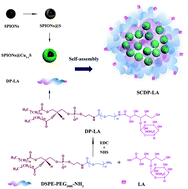SPION@Cu2−xS nanoclusters for highly sensitive MRI and targeted photothermal therapy of hepatocellular carcinoma†
Abstract
Considerable efforts have been made to incorporate both diagnostic and therapeutic functions into a single nanoplatform for biomedical applications. Herein, we report the synthesis and characterization of magnetite-loaded polymeric micelles (referred as SCDP-LA) for targeted magnetic resonance imaging (MRI) and photothermal therapy of hepatocellular carcinoma (HCC), by using an amphiphilic biocompatible polymer of lactobionic acid-modified 1,2-distearoyl-sn-glycero-3-phosphoethanolamine-N-[amino(polyethylene glycol)-2000] (DSPE-PEG-LA) for the micelle formation. A cluster of SPION@Cu2−xS is densely encapsulated inside the hydrophobic core of the micelles, which offers both highly sensitive MRI and an excellent photothermal effect. The LA-modified PEG outlayer makes this micelle stable in aqueous solution. Due to the targeting ligand of LA, the SCDP-LA clusters could be selectively internalized into the hepatocellular cell line (HepG2 cells) but not into HeLa cells. In addition, the targeted ability of the SCDP-LA aqueous solution was further confirmed by enhanced MRI with a shorter T2 relaxation time in HepG2 cells. Meanwhile, it also demonstrates excellent performance to produce significantly enhanced local photothermal killing efficiency against HepG2 cells under NIR laser irradiation. In summary, the present multifunctional nanoplatform based on SPION@Cu2−xS nanoclusters will be a promising theranostic platform for targeted MRI-guided photothermal therapy.


 Please wait while we load your content...
Please wait while we load your content...